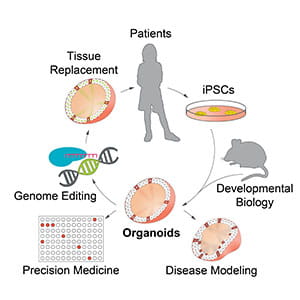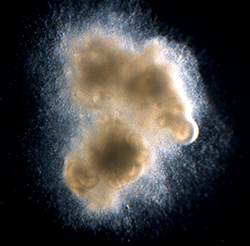 |
|
Organoids in regenerative medicine |
CuSTOM is a collaborative, multi-disciplinary center of excellence integrating scientists, clinicians, geneticists, surgeons, bioengineers and entrepreneurs with the common goal of accelerating discovery and facilitating bench-to-bedside translation of organoid technology.
Organoids in Regenerative Medicine
A convergence of breakthroughs in stem cell technology and developmental biology has enabled CuSTOM investigators to make induced pluripotent stem cells (iPSCs) and organoids, miniature versions of organs, from a patient’s own cells. While miniature in form, organoids have a tissue structure and physiology similar to normal organs. Organoids provide an unprecedented opportunity to study human organ development and physiology, investigate the cause of disease, and they provided a novel platform for drug screening and personalized regenerative medicine. A long-term goal is to generate tissues that could be transplanted into patients to cure disease (Figure).
 |
|
What are organoids? Organoids are miniature organs made from human pluripotent stem cells (hPSC) by replicating, in a petri dish the intricate series of molecular cues that control organ development. |
Organoids are made in the laboratory by recapitulating the processes of organ formation in a petri dish. Cincinnati Children’s Hospital is a world-leader in using animal models to understand how organs normally form during embryonic development through the use of cutting-edge molecular genetics, single cell genomics, live imaging and gene editing. With this information, we can now coax human pluripotent stem cells through a step-wise differentiation into forming three dimensional tissue organoids. We can now make liver, intestine, stomach and colon organoids with complex tissue structures and multiple cell types including epithelium, muscle, fibroblasts, endocrine cells and even nerves that replicate much of normal human organ physiology.
Read more about organoids in this Nature article.
Vision for the Future
Our vision at Cincinnati Children’s CuSTOM is to use new innovative stem cell and organoid technologies to change the outcome of regenerative medicine in the 21st century. Ongoing basic research studies are exploring the fundamental mechanisms of human organ development and disease. Our clinical researchers are using organoids made from patient’s stem cells to study disease pathogenesis, develop better diagnostic tools and identify new therapeutic targets. Gene editing is being used to correct disease causing mutations in organoids and in collaboration with pharmaceutical partners, we use organoids for personalized drug screening. Ultimately we aim to make tissue that can cure disease. Learn more about our current research programs.



